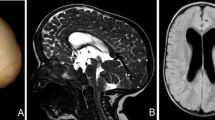Abstract
Introduction
Spontaneous resolution of Chiari I abnormality is very rare. In most patients, the radiological abnormality either stays unchanged with time or deriorates.
Case report
We present a male patient who was diagnosed at the age of 18 months as having radiological evidence of Chiari I malformation without syringomyelia, which had resolved 5 years later on a subsequent MR scan. At the time of initial diagnosis, he had been experiencing recurrent jerking movements of his body and was a sufferer of chronic renal failure.
Discussion
The symptoms were thought to be unrelated to the hindbrain hernia. Such spontaneous resolution of an isolated Chiari I malformation has only been described once more before, although resolution of hindbrain hernia associated with syringomyelia has been described before in several cases, albeit at single figures. The mechanism for such a natural evolution is not clear.
Conclusion
This patient demonstrates that surgical treatment should not be considered hastily in patients with radiological evidence of Chiari I in the absence of convincing associated clinical symptoms.


Similar content being viewed by others
References
Barkovich AJ, Wipppold FJ, Sherman JL, Citrin CM (1986) Significance of cerebellar tonsil position on MR. Am J Neuroradiol 7:795–799
Mikulis DJ, Diaz O, Egglin TK, Sanchez R (1992) Variance of the position of the cerebellar tonsils with age: preliminary report. Radiology 183:725–728
Elster AD, Chen MYM (1992) Chiari I malformation. Clinical and radiological appraisal. Radiology 183:347–353
Wu YW, Chin CT, Chan KM, Barkovich AJ, Ferriero DM (1999) Pediatric Chiari I malformations. Do clinical and radiological features correlate? Neurology 53:1271–1275
Meadows J, Kraut M, Guarnieri M, Haroun RI, Carson BS (2000) Asymptomatic Chiari type I malformations identified on magnetic resonance imaging. J Neurosurg 92:920–926
Schijman E, Steinbok P (2004) International survey on the management of Chiari I malformation and syringomyelia. Childs Nerv Syst 20:341–348
Marion Padilla M, Marion Padilla TM (1981) Morphogenesis of experimentally induced Arnold–Chiari malformation. J Neurol Sci 50:29–55
Stovner LJ, Bergan U, Nilsen G, Sjaastad O (1993) Posterior cranial fossa dimensions in the Chiari I malformation: relation to pathogenesis and clinical presentation. Neuroradiology 35:113–118
Pierallini A, Ferone E, Colonnese C (1997) Magnetic resonance images of a case of spontaneous resolution of syringomyelia associated with type I Chiari malformation. Radiol Med (Torino) 93:621–622
Sun PP, Harropp J, Sutton LN, Younkin D (2001) Complete spontaneous resolution of childhood Chiari I malformation and associated syringomyelia. Paediatrics 107:182–184
Klekamp J, Laconette G, Samii M (2001) Spontaneous resolution of Chiari I malformation and syringomyelia: case report and review of the literature. Neurosurgery 48:664–667
Sun JCL, Steinbok P, Cochrane DD (2000) Spontaneous resolution and recurrence of a Chiari I malformation and associated syringomyelia. J Neurosurg (Spine2) 92:207–210
Olivero WC, Dinh DH (1992) Chiari I malformation with traumatic syringomyelia and spontaneous resolution: case and literature review. Neurosurgery 30:758–760
Santoro A, Delfini R, Innocenzi G, Di Biasi, Transimeni G, Gualdi G (1993) Spontaneous drainage of syringomyelia. Report of two cases. J Neurosurg 79:132–134
Castillo M, Wilson JD (1995) Spontaneous resolution of a Chiari I malformation: MR demonstration. Am J Neuroradiol 16:1158–1160
Williams B (1990) Syringomyelia. Neurosurg Clin N Am 1:653–685
Acknowledgements
The material of this paper has been presented as a poster at the XVIII Congress of the European Society for Pediatric Neurosurgery, Kiruna, Lappland, 14–18 June 2002.
Author information
Authors and Affiliations
Corresponding author
Rights and permissions
About this article
Cite this article
Jatavallabhula, N.S., Armstrong, J., Sgouros, S. et al. Spontaneous resolution of isolated Chiari I malformation. Childs Nerv Syst 22, 201–203 (2006). https://doi.org/10.1007/s00381-005-1213-6
Received:
Published:
Issue Date:
DOI: https://doi.org/10.1007/s00381-005-1213-6




